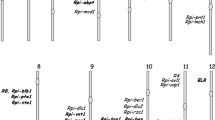Abstract
Potato is an important crop, grown worldwide. It suffers from many pests and diseases among which late blight, caused by the oomycete Phytophthora infestans, is the worst. The disease is still causing major damage in many potato production areas and control is only possible by applying fungicides frequently. The knowledge on the molecular biology and genetics of the interaction between the plant and the oomycete is developing rapidly. These are relevant fields of study, currently dominated by the discovery of many resistance genes and numerous effector proteins and the analysis of their specific mode of action. These studies may yield essential information needed for the development of durable resistance. The long-term and worldwide effort to breed for resistance so far has had little effect. A novel breeding approach may change this. It is based on cisgenic modification (CM) consisting of marker-free pyramiding of several resistance genes and their spatial and temporal deployment yielding dynamic varieties that contain potato genes only. It is envisioned that this CM approach with potato’s own genes will not only prove societally acceptable but may also result in simplifications in the legislation on use of the CM approach. Various parties in the potato research arena intend to cooperate in this novel approach in a number of developing countries where potato substantially contributes to food security. The use of resources such as land, water and energy improves when the effect of late blight is markedly reduced.






Similar content being viewed by others
References
Audsley E, Alber S, Clift R, Cowell S, Crettaz P, Gaillard G, Hausheer J, Jolliett O, Kleijn R, Motensen B, Pearce D, Roger E, Teilon H, Weidema B, van Zeijts H (1997) Harmonisation of environmental Life Cycle Assessment for agriculture. Final Report Concerted Action AIR3-CT94-2028. European Commission DG VI Agriculture, Silsoe, UK
Birch PRJ, Rehmany AP, Pritchard L, Kamoun S, Beynon JL (2006) Trafficking arms: oomycete effectors enter host plant cells. Trends Microbiol 14(1):8–11
de Vetten N, Wolters A, Raemakers K, van der Meer I, ter Stege R, Heeres E, Heeres P, Visser R (2003) A transformation method for obtaining marker-free plants of cross-pollinating and vegetatively propagated crops. Nature Biotech 21:439–442
de Wolf M, van der Klooster A (2006) Kwantitatieve Informatie Akkerbouw en Vollegrondsgroenteteelt 2006. Praktijkonderzoek Plant & Omgeving, Wageningen, PPO report 354
Haverkort AJ, Boonekamp PM, Hutten R, Jacobsen E, Lotz LAP, Kessel GJT, Visser RGF, van der Vossen EAG (2008) Societal costs of late blight in potato and prospects of durable resistance through cisgenic modification. Potato Res 51:47–57
Green MB (1987) Energy in pesticide manufacture, distribution and use. In: Helsel ZR (ed) Energy in plant nutrition and pest control. Energy in world agriculture 2. Elsevier, Amsterdam, pp 165–177
Jacobsen E, Schouten HJ (2007) Cisgenesis strongly improves introgression breeding and induced translocation breeding of plants. Trends Biotechnol 25:219–223
Jacobsen E, van der Vossen EAG (2009) Plant disease resistance: breeding and transgenic approaches. In: Schaechter M (ed) Encyclopedia of microbiology. Elsevier, Oxford, pp 597–612
Jiang RHY, Tripathy S, Govers F, Tyler BM (2008) RXLR effector reservoir in two P-species is dominated by a single rapidly evolving superfamily with more than 700 members. Proc Natl Acad Sci USA 105:4874–4879
Jochemsen H (2008) An ethical assessment of cisgenesis in breeding late blight resistant potato. Potato Res 51:59–73
Lammerts van Bueren ET, Struik PC, Tiemens-Hulscher M, Jacobsen E (2003) The concepts of intrinsic value and integrity of plants in organic plant breeding and propagation. Crop Sci 43:1922–1929
Lammerts van Bueren ET, Tiemens-Hulscher M, Struik PC (2008) Cisgenesis does not solve the late blight problem of organic potato production: alternative breeding strategies. Potato Res 51:89–99
Soanes DM, Talbot NJ (2008) Moving targets: rapid evolution of oomycete effectors. Trends Microbiol 16:507–510
Vleeshouwers VGAA, Rietman H, Krenek P, Champouret N, Young C, Oh SK, Wang M, Bouwmeester K, Vosman B, Visser RGF, Jacobsen E, Govers F, Kamoun S, van der Vossen EAG (2008) Effector genomics accelerates discovery and functional profiling of potato disease resistance and Phytophthora infestans avirulence genes. PLoS ONE 3 e2875
Zadoks JC (2008) The potato murrain on the European continent and the revolutions of 1848. Potato Res 51:5–45
Author information
Authors and Affiliations
Corresponding author
Rights and permissions
About this article
Cite this article
Haverkort, A.J., Struik, P.C., Visser, R.G.F. et al. Applied Biotechnology to Combat Late Blight in Potato Caused by Phytophthora Infestans . Potato Res. 52, 249–264 (2009). https://doi.org/10.1007/s11540-009-9136-3
Received:
Accepted:
Published:
Issue Date:
DOI: https://doi.org/10.1007/s11540-009-9136-3




